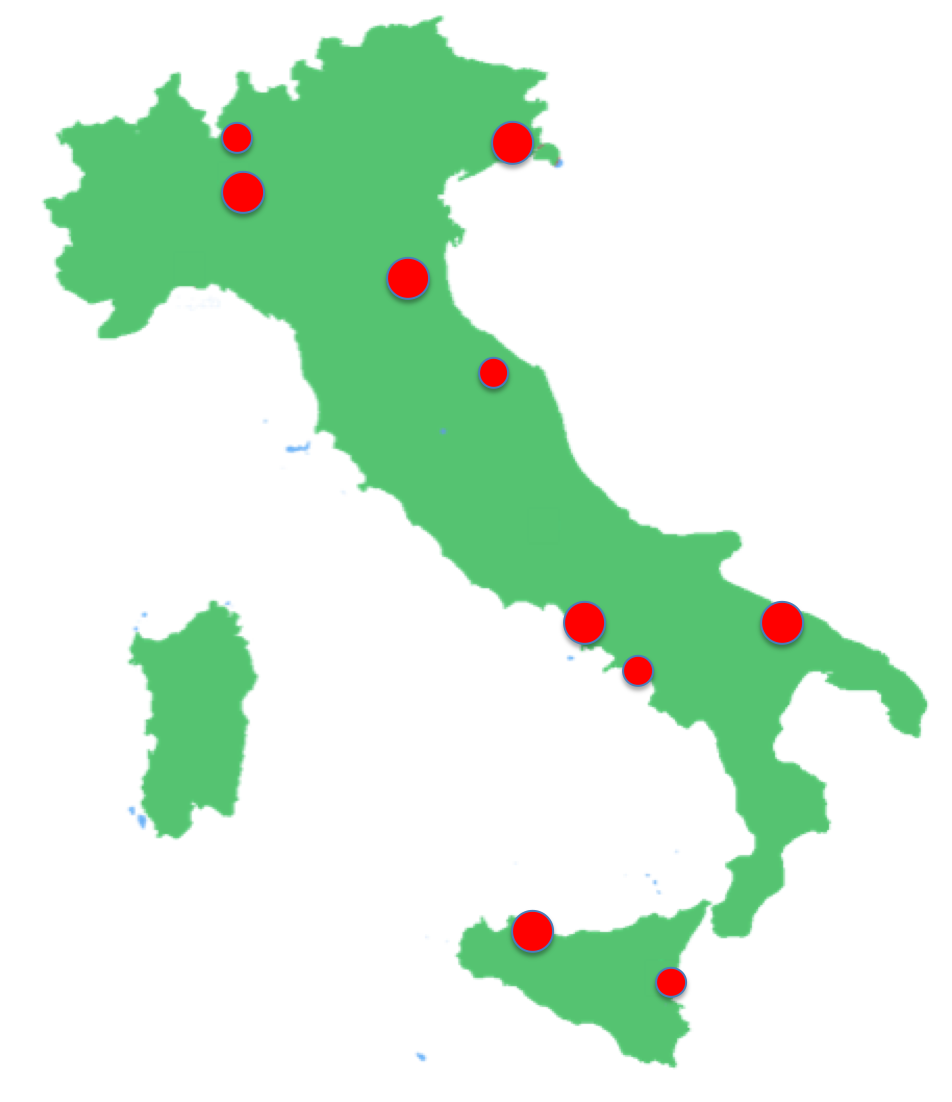Scientific activities of the various Research Units
Bari
The Bari group investigates the physics of cold gases and waveguide
QED, and some features of quantum evolutions and quantum
metrology. The most recent activity is on the phase diagram of a
spin-orbit-coupled spin-1 condensate, and on a new scheme of
plenoptic imaging at the diffraction limit. The latter is also being
patented.
- BECs. The zero-temperature phase diagram of a spin-orbit coupled
condensate with spin 1 has been determined, for both attractive and
repulsive spin-spin interactions. We have found the existence of
emergent tricritical points
and "striped" phases, in which translation invariance is
spontaneously broken.
- Quantum imaging. We have unveiled the possibility of obtaining
plenoptic imaging by measuring intensity correlations of light,
either chaotic or entangled. The proposed scheme enables plenoptic
imaging at the diffraction limit, which is not allowed in
first-order plenoptic setups.
- Entanglement and Quantum dynamics. A system of two qubits coupled
with photons in a linear waveguide has been analyzed. In particular,
we have found that the existence of nontrivial bound states entails
the possibility of generating entanglement by relaxation.
- Quantum Boundary Conditions. We have unveiled the existence of a
non-trivial Berry phase associated to the dynamics of a quantum
particle in a box with moving boundaries. The geometric phase is
induced by a suitable choice of boundary conditions.
Among the most recent highlights:
Bologna-Camerino
The research of the Bologna group focuses on the study of static and
dynamic phase transitions of closed quantum many body systems in low
dimensions, through the study of entanglement entropy and the
calculation of dynamical quantities that rule the appearance of
ordered phases. We deal mainly with systems with long-range
interactions and/or which show many-body localisation. In addition,
in the spirit of quantum simulators, we study the implementation on
lattices of gauge field theories.
The research activity of Camerino is mainly devoted to quantum channels characterization. In particular, the idea of quantum channels with environment assistance has been put forward and in such a context conferencing capacity has been introduced. Furthermore a model of a non-Gaussian quantum channel that stems from the composition of two physically relevant processes occurring in open quantum systems (amplitude damping and dephasing) has been studied in terms of minimum output entropy. On another side, the notion of mutually unbiased unitary bases has been introduced and related to unitary 2-designs.
Catania-Palermo
The activity of the Catania-Palermo node focuses on the following main topics:
- Study of time dependent spin models;
- Driven-dissipative dynamics with non-Hermitian, time-dependent Hamiltonians with PT-symmetry;
- Quantum transport and quench in atomtronics circuits;
- Solitons in interacting many-body bosonic systems and ergodicity;
- Coherent transfer in non-linear circuit QED hybrid structures and synchronization process in chiral waveguides;
- Dynamical Casimir effect in many-atom systems.
Milano-Como
The activity of the Milano-Como node focuses on the following main
topics:
- Quantum transport and thermodynamics: search for mechanisms to
improve the efficiency of thermodynamic quantum machines; explore
interaction effects on heat to work conversion at the nanoscale;
find new mechanisms and realistic models for heat management and
efficient thermal rectification.
- Quantum information processing in the ultra-strong field-matter
coupling regime: explore fundamental limitations, due to the
dynamical Casimir effect, for quantum protocols and thermal
machines.
- Properties of transfer matrices originating from banded random matrices, also in relation to the Anderson localisation.
Napoli-Salerno
The activity on the Napoli-Salerno Unit focuses on two main research
lines.
- Casimir effect and Casimir-Polder interaction: by a systematic expansion of the interaction potential in powers of derivatives of the surface height profile, the Casimir-Polder interaction of a particle with a curved material surface was investigated. By means of this technique, one can determine the shift of the spectral lines of a diatomic polar molecule placed near a curved surface. Conformal invariance of Maxwell equations
in four euclidean dimensions has been exploited to compute the exact
Casimir interaction between two 3-spheres. The separability of Laplace
equation in bispherical coordinates has been exploited to study the
classical limit of the sphere-plate Casimir interaction.
- Semi-groups of operators: applications to open quantum systems and quantum information. The quantum dynamical semi-groups, completely positive or not, that increase a quantum entropy were classified. These results hold for the von Neumann entropy, as well as for a general class of functions including the Renyi and the Tsallis entropies. It was also shown that a quantum dynamical semi-group that does not decrease a quantum entropy can be realized as a “generalized twirling semi-group”. Time in quantum mechanics. A new approach was proposed to the problem of time in quantum mechanics, based on the idea of replacing the usual time operator (defined in the literature by various recipes) with a suitable real function on the space of states.
Trieste
The research of the Trieste group focuses on the study of the dynamics
of quantum correlations
in many-body systems with particular focus upon applications in
quantum thermodynamics and
non-equilibrium processes.
- In many-body systems, the dynamics of quantum correlations is affected
by dissipation and noise as in pump and probe experiments
where femtosecond laser pulses can be used to create squeezed
phonons on a metallic target and subsequently read off their
behavior.
- Many-body fluctuations scaling with the square root of the number of
particles inherit a quantum behavior from the microscopic one and
exhibit entanglement at the mesoscopic level.
- In non-equilibrium processes, the dynamics of quantum correlations affects the exchanges of heat ad work among the parties giving rise to non-Markovian effects. These can be better understood by treating the parties on a same footing rather than effectively eliminating one of them as a large environment.


